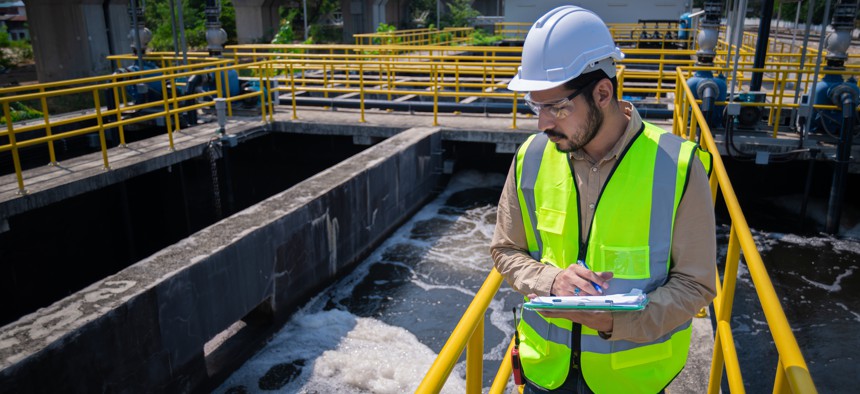States’ Role in Water and Wastewater Spending Secure, Says EPA

DSCimage via Getty Images
An agency official reassured state and federal officials that “states are very much in the driver's seat” in picking which projects to spend funds from the bipartisan infrastructure bill.
The top Environmental Protection Agency official on water policy reassured senators on Wednesday that the agency will give states flexibility in deciding how to spend the $48 billion for water and wastewater funds that was included in the bipartisan infrastructure bill.
“The states are very much in the driver's seat in selecting the projects that really meet the needs of their residents,” said Radhika Fox, the assistant administrator for water at the EPA.
At the hearing, West Virginia Sen. Shelley Moore Capito, the top Republican on the Senate Environment and Public Works Committee, raised concerns that the Biden administration would not just consider what areas are most in need of help with their water infrastructure, but that it would factor in other administration priorities as it distributes the money, including its Justice40 initiative to send 40% of funding to disadvantaged communities.
“The administration has not been shy to pull in political factors that are unrelated to water quality and health conditions for how this money should be spent,” Capito said. “I'm concerned that projects will not be considered based solely on [the criteria in the law].”
At issue are two state revolving funds (SRF) under the bipartisan initiative: the Clean Water SRF and the Drinking Water SRF. The criteria laid in these initiatives include safeguarding health, keeping water rates and fees low, and protecting the environment.
Katheryn Emery, director of the West Virginia Department of Environmental Protection’s water and waste management division, testified that a memo from regional EPA managers indicated that the agency would review whether states’ intended plans for the money meet the priorities that the EPA will create “in the coming months.”
“It was a bit of a surprise,” Emery said. “It has me a little concerned that there's going to be criteria that they're going to ask us to incorporate into our intended use [plans]. So you formulate the plan, it goes to EPA and then the agency comes back with criteria you haven't seen.”
The concerns over how the administration will implement the infrastructure law are similar to those raised by Capito and other Republicans in regards to highway funding following a December 2021 memo written by the then head of the Federal Highway Administration, Stephanie Pollack.
In it, Pollack said that while the Biden administration still recognized the authority of state transportation departments to select their own projects, some proposals like widening highways would receive more scrutiny, while others, such as bike and pedestrian infrastructure, would be subject to less project-by-project scrutiny.
Shailen Bhatt, the newly installed head of the FHWA, recently issued a new memo that explicitly recognized the authority of state agencies to decide how to spend federal highway money that Congress allocates to states based on a predetermined formula.
At the hearing, Fox repeated to the senators points that she had emphasized in a March 8 memo to the managers of the two state revolving funds. “We value the flexibility that states have always had,” she said, noting that the “money can be used for a diverse set of purposes, including for drinking water, wastewater and stormwater, [as well as for] small projects, big projects and cybersecurity.”
Fox noted, the law requires that, depending on the program under the SRF initiatives, a percentage of money must be provided as grants and forgivable loans to disadvantaged communities. For example, at least 25% of money under the Emerging Contaminants Funding program has to be provided as grants and forgivable loans to disadvantaged communities or public water systems serving fewer than 25,000 people.
In addition to allowing states to choose which projects to fund, Fox also said that the federal government will not dictate how states will define disadvantaged communities. “States are the ones that determine the definition of disadvantaged communities both on the Clean Water SRF side as well as the Drinking Water SRF side,” she pledged at the hearing.
However, Randy Hayman, Commissioner and CEO of the Philadelphia Water Department, representing the Association of Metropolitan Water Agencies, said the federal government should set a baseline on how states should define disadvantaged communities.
“Because states do not use consistent metrics for determining which water systems serve disadvantaged communities, a water system in one state may benefit from this additional subsidization, while one serving a similar community in another state may not,” he wrote in his written testimony to the committee.
Delaware Sen. Thomas Carper, the Democratic chairman of the Senate Environment and Public Works Committee, also worried how states will carry out the push to make sure disadvantaged communities will get their share of the money. Some states make it harder for disadvantaged communities to get the infrastructure funding, he said.
“State policies such as project ranking systems and additional eligibility criteria create barriers to disadvantaged and underserved communities’ ability to access funds,” Carper said. “What is the agency's plan to help communities overcome these barriers so that they can access federal investment in water infrastructure?”
Fox said some states have policies like making grants available several times a year, which increase the workload for staff at smaller communities and makes it more difficult to keep track of when applications are due.
“We are very closely partnering with the states to work through those together,” she said
Kery Murakami is a senior reporter for Route Fifty.
NEXT STORY: Why community digital equity discussions should be in person






